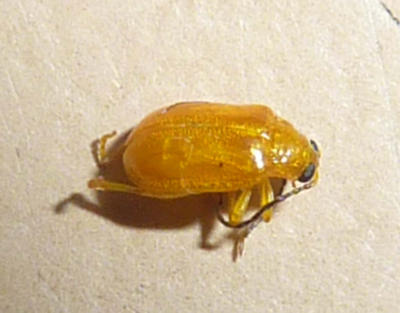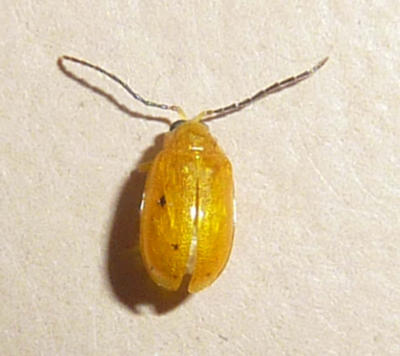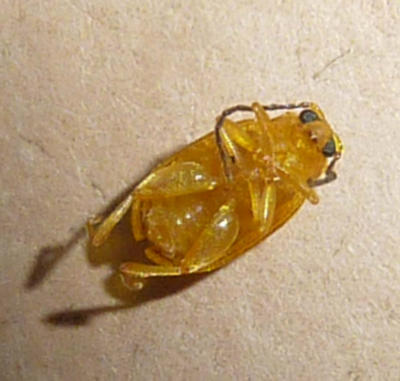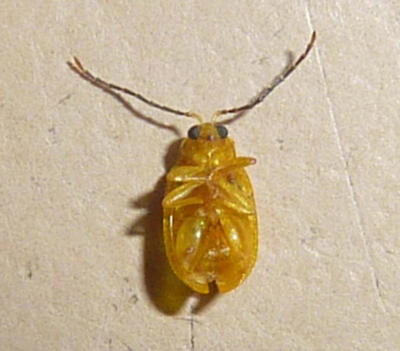Yellow-legged Parchicola Flea Beetle (Parchicola DF2)
This species occurs primarily on P. auriculata and P. biflora, the two most common species of Passiflora subgenus Decaloba. A small but significant number (about 10%) have also been seen on P. lobata (also in Decaloba), a plant whose foliage is protected by hooked trichomes. A rare few (< 5%) have even been seen on P. vitifolia and P. oerstedii, species outside of Decaloba but which produce minimal amounts of HCN gas when crushed.
Until 2011 this and the Black-legged Yellow flea beetle (Parchicola DF1) were grouped together as one species "yellow Monomacra." This erroneous grouping contributed to the perception that these were a single Passiflora-generalist species, when in fact we believe there are at least three species. This one with yellow legs appears to be specialized to feed on Decaloba, while the other two (with black legs) prefer subgenus Passiflora, including P. oerstedii (Parchicola "yellow tibia") and P. vitifolia (Parchicola "black tibia"). However, genetic "barcode" analysis suggested possible additional genetic complexity within Parchicola "yellow legged" (Pa. DF2). Four of the 13 individuals sampled were slightly dissimilar from the remaining 9, with similarity indices ranging from 90 to 96% instead of the usual 98 to 100% among members of a species. However, those four did not group together and so probably do not represent a separate group. As well, the similarity gap between the 13 Pa. DF2 and the other flea beetle species is still quite large. Thus, the Pa. DF2 barcode sample may include some additional genetic variation as compared to the other species.
A captive Parchicola "yellow-legged" population in isolation cages laid at least one batch of 20 eggs on tiny rootlets just below ground level, on P. biflora, and 6 weeks later, on P. auriculata. They look similar to the eggs laid on the underside of P. oerstedii leaves by Parchicola "yellow-tibia". Larvae were not found on the P. biflora batch, but there may have been some new recruitment of adults later. The P. auriculata batches hatched into tiny first instars about the size and shape of the eggs. These were seen crawling along the tiny rootlets. Another set of captive Parchicola DF2 adults laid a batch of eggs on the under side of the most basal P. auriculata leaf. Eggs are glued to the substrate on their side, unlike Monomacra violacea which glues her eggs on end.
The tiny larvae possess pigmented sacs on the dorsal-lateral protuberances, one row on each segment. As the larvae grow the sacs almost certainly fill with an unknown fluid and become spherical and transparent, losing the pigment. This does not appear to take place until after the first instar, however. The sacs are similar but not identical to those of Monomacra violacea, which have two rows of sacs per segment and are smaller. Also, the filled sacs are larger for the Parchicola larvae than for Monomacra. The larvae feed on the host plant rootlets, eating the pith but not the hard stem core. It is interesting that the host P. auriculata has cyanogenic roots, producing 1-6 μM/g HCN when crushed. This is an order of magnitude over what the foliage contains. P. biflora roots, in contrast, produce much less HCN when crushed, less than P. auriculata and less than biflora foliage (see Figure 2b).
I expect the later stage larvae to be light yellow colored with many protuberances, each of which are tipped with tiny spherical "balloon" organs, as may be seen on the web page for Pa. "yellow tibia".



